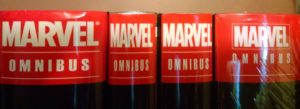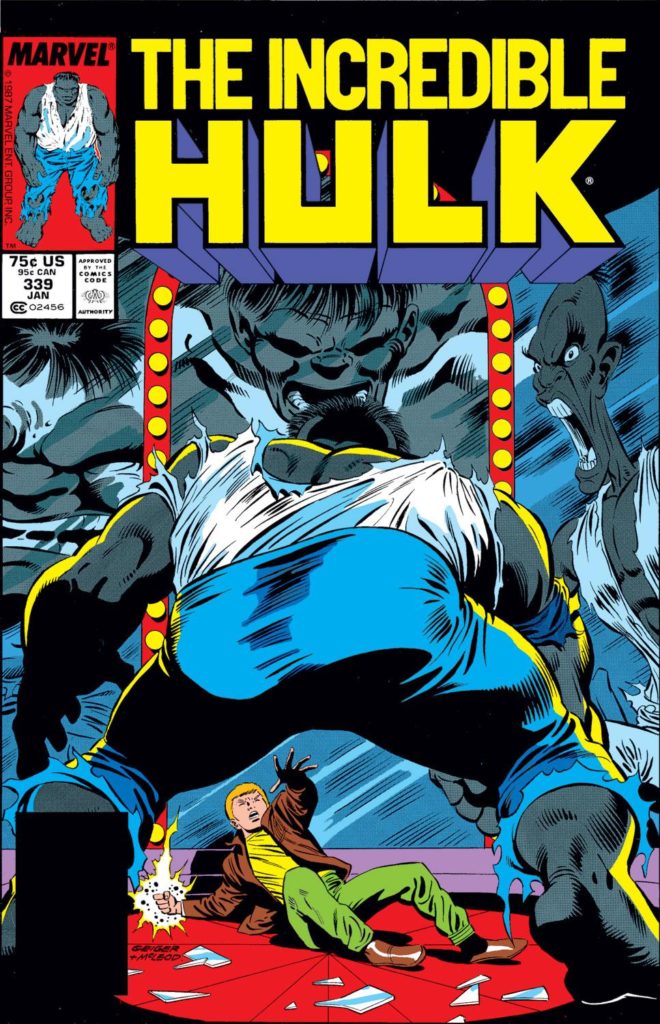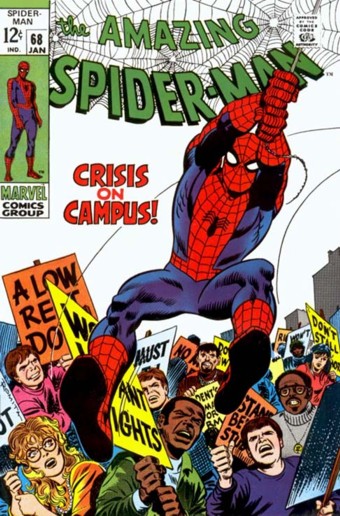 Welcome back for the next pair of books from the Most-Wanted Marvel Omnibus secret ballot by TigerEyes. I covered #5 & 6 in the last installment.
Welcome back for the next pair of books from the Most-Wanted Marvel Omnibus secret ballot by TigerEyes. I covered #5 & 6 in the last installment.
Today’s installment of the next pair of books on the survey is a pair of prohibitively classic runs – one from the early 70s and another from the mid-80s. Even without the ballot results in front of me, I’d probably name these as two of the most famous single-creator streaks in Marvel’s pre-00s history.
For one of the runs I even took the unusual, exceedingly-rare step of recruiting a guest author to make sure I’ve got the details right.
(Clearly, that run is not The X-Men ;)
Marvel has released these oversized omnibus editions for over a decade now, with a staggering amount of their most-popular material now covered in the format – from Silver Age debuts to modern classics. Is your favorite character or run of issues already in an Omnibus? My Marvel Omnibus & Oversized Hardcover Guide is the most comprehensive tool on the web for answering that question – it features every book, plus release dates, contents, and even breakdowns of $/page and what movies the books were released to support.
Okay, here we go – the fourth and third of Marvel’s most-wanted Omnibuses!
![]()
#4. The Incredible Hulk by Peter David, Vol. 1
Last Year’s Rank: #2
Probable Contents: Incredible Hulk #331-360 or 363 or 367, Fantastic Four #320, Web of Spider-Man #44, Marvel Comics Presents #26 & 45, Avengers Annual 17, Iron Man 247, encompassing art from Todd McFarlane and Jeff Purves.
Possible Contents: On one hand, this could pick up some establishing plot threads by starting with Al Milgrom’s brief run from #320. Alternately, it could extend through #372 and Annual 16, but the art chores switch up at #367, making it a better break point. Either way, it’s likely a second volume would reach #396 (we’ll explain why below).
 What is it: The beginning of one of Marvel’s longest modern single-author runs, which played host to several of comics’ hottest artists and (finally) made Incredible Hulk a must-read title.
What is it: The beginning of one of Marvel’s longest modern single-author runs, which played host to several of comics’ hottest artists and (finally) made Incredible Hulk a must-read title.
The Details:
Here’s an amazing, mighty, uncanny, but especially incredible fact – this volume is now the most-wanted volume across all four years of the Omnibus survey! It merits all of those adjectives not only because of its most-wanted status, but because it has ruled the ballot despite not being Silver Age material and not having any association with the letter “X”. That means it loses a massive voting block of slightly older readers who don’t love 80s material they way they do 60s and 70s, plus all the X-Men fanatics such as myself. Despite that, it has ranked 2, 4, 2, and 4 in four years of the survey.
I am truly not an expert of any measure on the jade giant. To do this All-Time Most-Wanted volume justice, please allow me to introduce my colleague from the venerable Comic Book Resources Collected Editions discussion thread, GrahamGG.
Take it away, Mr. GG!
Caught in the heart of a nuclear explosion, victim of gamma radiation gone wild! Doctor Robert Bruce Banner finds himself transformed in times of stress into seven feet, one-thousand pounds of unfettered fury! Stan Lee Presents: THE INCREDIBLE HULK!” This top copy which appeared on the opening pages of Hulk comics in the 1980s is practically seared into my brain from reading Hulk comics over and over and over again as a kid in elementary school!
The Hulk was, by far, my favorite comic/cartoon character and I first learned about the character watching the live action TV show on Friday nights. I couldn’t have been more than 4 or 5 by the time the show ended, but the damage was done. I devoured anything Hulk I could find or get my hands on: the 1982 cartoon “The Spider-Man and Hulk Action Hour!”,;rack toys and Mego figures; and various sticker books and coloring books all given to me by my mom and grandmother. If it was anything to do with the Hulk, I had to HAVE IT! or READ IT! or LEARN ABOUT IT! You could say I was hooked on the green goliath at a very early age.
When Peter A. David first took over the series it was by and large directionless. The plots were all over the place. Roughly one year earlier, John Byrne had left the book (in an editorial dispute with Jim Shooter with issue #319; Byrne’s unpublished #320 would later see the light of day as Marvel Fanfare #29). Byrne’s short run did two major things to the Hulk and his supporting cast. The first and most substantial was that the Hulk had been split from Bruce Banner. The second was the marriage of Banner and longtime love interest Betty Ross.
Al Milgrom took over with #320 and hastily had the Hulk and Banner re-merged (with a little help from Doc Samson and the Vision, after a massive battle royale with the Avengers in #321-323). However, Milgrom threw a monkey-wrench in the works: when the Hulk and Banner were re-merged, the Hulk reverted to a smaller stature and gray appearance – one that had not been seen since since the original Hulk #1 from 1962! Also, in a random twist of fate, longtime sidekick Rick Jones was accidentally submerged in the same nutrient bath Doc Samson used to re-merge Banner and the Hulk. As a result, Rick Jones began changing into a young, long-haired, green-skinned Hulk at night while Banner (eventually) began turning into a slightly less massive, but more crafty, smart gray Hulk, also at nightfall.
As the story goes, PAD was handed the Hulk book and told he could do what he wanted with it. Sales were down, a new kid named Todd McFarlane was on the book as artist, and there were two Hulks he could use! He was given the creative freedom to write stories as he saw fit, and slowly, the book became a sleeper hit!
PAD began by bringing back Samuel Sterns aka the Leader, with a twist! Over the years, the Leader’s gamma-irradiated intellect had slowly worn off and he was now just a regular guy. Sterns tricked the gray Hulk into helping him capture and drain the gamma energy from the n32 Rick Jones Hulk. Sterns then tried to use the siphoned energy to regain his super-intellect. But things rarely go according to plan, and while Rick Jones was cured, Sam Sterns transformed into a more mutated version of the Leader (with giant veiny head!) and Bruce Banner was once again transforming into the gray Hulk at nightfall. The Leader returns later in this run.
Despite this early gamma-powered blow-up, PAD’s early run is marked by a series of dark & twisted (for mid-1980s Marvel books) standalone stories. Hulk takes on a small town sheriff who uses extreme measures to keep his town (and family) in-line,. He meets and defeats a nasty new villain, Half-Life, who absorbs the life essence of others. He fights a grisly ghost murderer in a story that would have seemed right at home on Tales From the Crypt.
This sequence of issues are some of my all time favorites for the new creative spark that PAD (and McFarlane) brought to the series. Sure, McFarlane was not yet TODD MC-FREAKING-FARLANE, but he was miles better than vanilla old Al Milgrom! And PAD may not have known at first where he was headed with the series, but the crazy new directions were a breath of life.
In one memorable and hilarious sequence the Hulk gets himself completely wasted drunk by drinking an entire liquor store’s inventory immediately before daybreak, simply to keep Banner incapacitated the entire next day! Hilarious, yet crafty! In another sequence we see one of the most interesting transformation sequences shown on the comic page where the Hulk actually “eats” Banner (#332 – the transformation is shown from Banner’s perspective in his mind’s eye).
Incredible Hulk #340 features the now-classic battle to end all battles with Wolverine. As the X-Men head towards Dallas (during Fall of the Mutants), Wolverine steps out on his own for a bit and runs smack into the gray Hulk in the middle of a blizzard! Chaos ensues and the end result is one of the most well-remembered, brutal Hulk/Wolverine battles of all time. McFarlane really kills it on the artwork as he starts inking himself for the first time.
Things come to a boil with the conclusion of the “Ground Zero” story arc in #345 as the Hulk, Betty, Rick, and Clay Quartermain all finally catch up to the Leader just as he detonates a gamma bomb in Middletown with the Hulk literally at ground zero, and presumed dead after the blast.
After an epilogue to Ground Zero, Hulk starts a new era with the gray Hulk popping up as mob enforcer in Las Vegas going by the name Joe Fixit! There is no Bruce Banner incarnation of this Hulk – he’s all gray, all the time. New artist Jeff Purves handles this run with a more cartoonish style. That’s a good match, considering the darkest issues are behind us. Gray Hulk tangles with the likes of Spider-Man, The Thing, and Doctor Doom – bringing a new strategic angle to their battles.
Whew – many thanks to GrahamGG for that awesome breakdown, which he delivered to me in quite a pinch!
While this run has been collected in Hulk Visionaries volumes, the first volume was released over a decade ago – plus, the reprint line stalled out in the midst of Davids’ lengthy run. Not only would it be awesome to have this material recollected in a premier format, it would get the ball rolling on what would be AT LEAST four volumes to cover over 130 issues of the run.
Chances we see this in 2017? ![]() Marvel just plunked down two Epic collection in the midst of David’s run – from #397 to the late 410s. Given that all of this material is in pretty high demand, there’s an argument to made that these Epics form dotted lines drawn at the edges of a bigger run meant for Omnibus editions. With Hulk starring in Thor: Ragnarok last year, I think we have a hope.
Marvel just plunked down two Epic collection in the midst of David’s run – from #397 to the late 410s. Given that all of this material is in pretty high demand, there’s an argument to made that these Epics form dotted lines drawn at the edges of a bigger run meant for Omnibus editions. With Hulk starring in Thor: Ragnarok last year, I think we have a hope.
Want to read it right now? The long-ago Peter David Visionaries hit this run as a whole – head to the Hulk Guide for the breakdown.
![]()
#3. Amazing Spider-Man, Vol. 3
Last Year’s Rank: #1
Probable Contents: #68-99 & Marvel Super-Heroes (1967) #14
What is it? More prohibitive Peter Parker classics penned by Stan Lee and drawn by John Romita, with nearly every villain you can name and a focus on Spider-Man’s personal life.
The Details:
 This run finds Peter Parker attending Empire State University in 1969 while rooming with Harry Osborn and dating Gwen Stacey – a classic status quo with elements used by multiple Spidey films.
This run finds Peter Parker attending Empire State University in 1969 while rooming with Harry Osborn and dating Gwen Stacey – a classic status quo with elements used by multiple Spidey films.
Stan Lee makes great use of this hip setting current events in the world, opening this run with a protest on campus that turns into a riot and ending on the famous anti-drug story that ran without approval of the comics code. He also focuses on the mob aspects of Marvel’s NYC backdrop, using the riot to obscure criminal activity by Kingpin while introducing his wife Vanessa.
Along the way, Lee uses Spider-Man’s full gallery of classic rogues like Electro, Lizard, Doctor Octopus, Chameleon, and Green Goblin – plus debuts The Prowler, Maggia leader Silvermane, and The Kangaroo (well, you can’t win ’em all). Kingpin – a Spider-Man villain until Miller took over Daredevil – is the common thread, reappearing to tie together several plot threads.
Eschewing the one-and-done plots of many other Marvel titles of the day, Lee tells a continuing soap opera of Peter Parker’s life punctuated by the arrival of his villains. The personal drama of his bumpy relationship with Gwen, lack of job and cash, and jealousy of Flash drives the story, sometimes causing him to be uncharacteristically hot-headed as he handles his foes.
Some of them even bleed into his personal life, as when The Prowler gets him out of a pinch with Gwen on her birthday and when Doctor Octopus’s out-of-control tentacles kill Captain Stacey!
Marvel has no reason not to solicit this volume – the Spider-Man omnibuses sell like gangbusters, and both FF and UXM have seen their Volume 3s do well – breaking the “Third Volumes Don’t Sell” spell that Marvel was under. Plus, this is prime Spider-Man material – classic stories that move briskly and look unbelievably modern thanks to John Romita’s realistic figure work. I recently read the trio of anti-drug issues from the close of this run, and they were incredible – Lee’s writing is still wordy, but they don’t have the dated feel of other early-70s material.
Members of Marvel’s Collections Department have stated pretty plainly the they think of Silver Age omnibuses as three Marvel Masterworks volumes, despite some early omnis breaking that ruling. They obeyed they rule dogmatically for Fantastic Four, Vol. 3 even though they could have added another MMW’s worth of issue to round out the Lee/Kirby legendary run. They also whipped UXM Vol. 3 out as soon as they cleared three MMWs. There’s no reason to think they’d break the rule for Spider-Man, even with Lee’s classic run expiring a scant 10 issues later here. It helps that these issues happen to tell a definitive and surprisingly self-contained arc of stories.
Chances we see this in 2017? ![]() When? Well, maybe you’ve heard – Marvel has this little Spider-Man movie coming out in 2017. While that will focus on a high school aged Spider-Man, the younger Spidey and classic plot of this volume is a perfect fit to release as a companion.
When? Well, maybe you’ve heard – Marvel has this little Spider-Man movie coming out in 2017. While that will focus on a high school aged Spider-Man, the younger Spidey and classic plot of this volume is a perfect fit to release as a companion.
Want to read it right now? You’ve got a few options for collecting this run in whole or parts – see the all-encompassing Spider-Man Guide for the details.
![]()
[…] Amazing Spider-Man, Vol. 3 #4. The Incredible Hulk by Peter David, Vol. […]